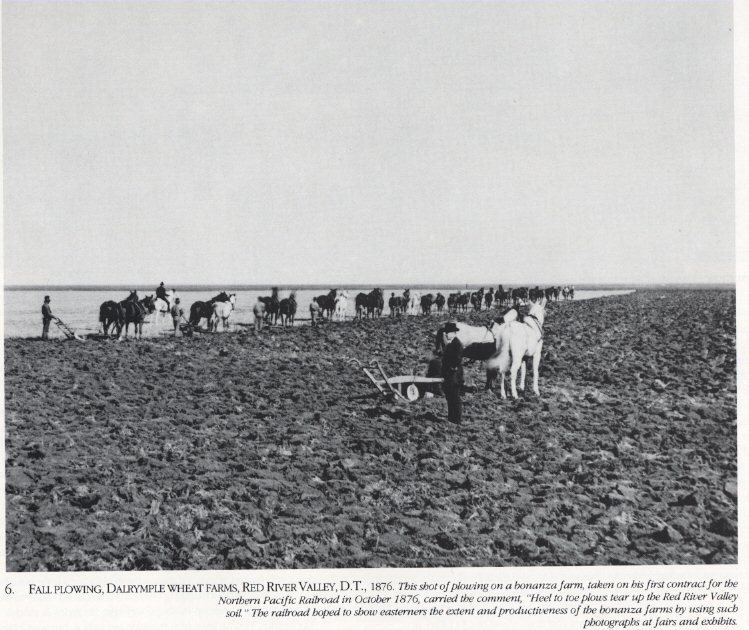 | ||
Bonanza farms were very large farms established in the western United States during the late nineteenth century. They conducted large-scale operations, mostly cultivating and harvesting wheat. Bonanza farms developed as a result of a number of factors, including the efficient new farming machinery of the 1870s, cheap abundant land available during that period, the growth of eastern markets in the U.S., and completion of most major railroads between the farming areas and markets.
Contents
- Origins of Bonanza Farms
- Role of farm technology
- Dependence on migrant labor and demise of bonanza farms
- Historic site
- References
Most bonanza farms were owned by companies and run like factories, with professional managers. The first bonanza farms were established in the mid-1870s in the Red River Valley in Minnesota and in Dakota Territory. Developers bought land close to the Northern Pacific Railroad, for ease of transport of their wheat to market. Investors also organized bonanza farms farther west.
Many bonanza farms were established in this period in North Dakota; a number have been preserved.
Origins of Bonanza Farms
Bonanza farms were encouraged by John Wesley Powell who, by the 1870s, had found that the land he studied needed larger-scale irrigation systems that would lead to larger areas of land being taken care of. Powell, a geologist, asserted that family-owned farms that had been in use in accordance to the Homestead Act of 1862 did not quite give the land the type of help required to keep it fit. Though less numerous than family farms, the Bonanza operations began to be competitive with the smaller operations.
Role of farm technology
Bonanza farmers pioneered the development of farm technology and economics. They used steam engines to power plowing as much as 41 years before the modern farm tractor made its first appearance. Plows and combine harvesters drawn by steam tractors were used in the West in the 1880s and 1890s, well before mechanization of the smaller midwestern farms. The division of labor was applied in bonanza farms generations before family farms adapted to these modern ways. Farm boys from the midwest, working on bonanza farms in the early 20th century, transplanted these ideas to Corn Belt homesteads and built larger farms as the century progressed. (An example is Fred Geier, of Lynn Township, McLeod County, Minnesota and Boon Lake Township, Renville County, Minnesota. Migrating to the Dakotas in the early 20th century, he became a progressive farmer; he performed custom threshing and milling at a time when others in the townships were farming with horses on a very small scale. In addition, he invented the Geier Hitch.
Dependence on migrant labor and demise of bonanza farms
Bonanza farming was dependent on the use of seasonal migrant labor. At planting and harvesting times foremen often supervised some 500 to 1000 extra workers on a bonanza farm. When weather and market conditions were good, bonanza farms made large profits; because the managers could buy seeds and equipment in bulk, they had lower production costs. But in times of drought or low wheat prices, their profits fell. As the Red River Valley was developed for agriculture, the Bonanza farms were distinguished by their widespread use of migrant labor, some of whom were Mexican immigrants or migrants, known as braceros. European Americans also worked as migrant laborers. Family farmers, with fewer workers to pay and less money invested in equipment, could better handle boom-and-bust cycles. By the 1890s, most bonanza farms had broken up into smaller farms.
Historic site
The Frederick A. and Sophia Bagg Bonanza Farm is located in southeastern corner of North Dakota. The preserved Bagg Bonanza Farm was designated as a National Historic Landmark in 2005. Welcoming 60,000 visitors per year, a must see, Bonanzaville. Bonanzaville.
